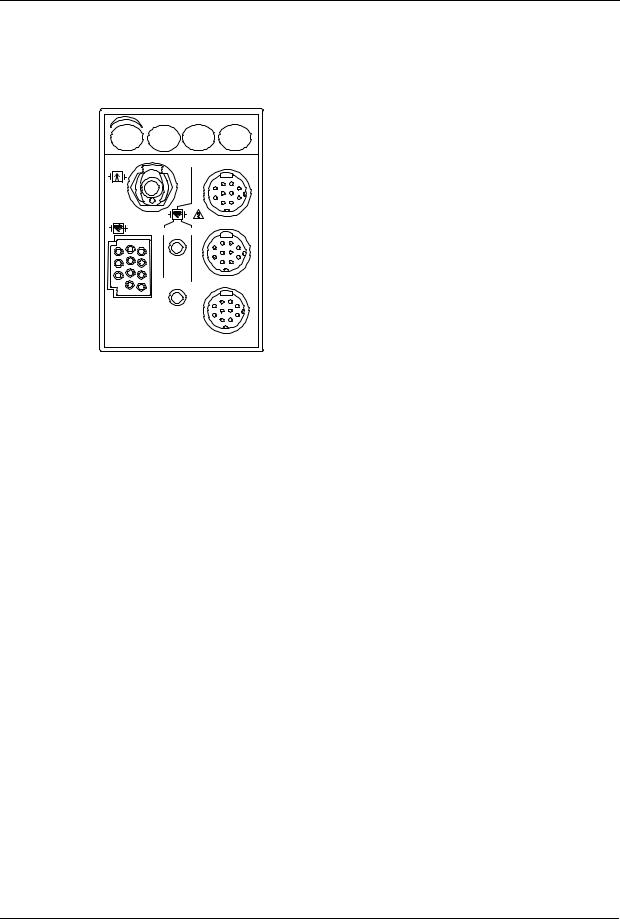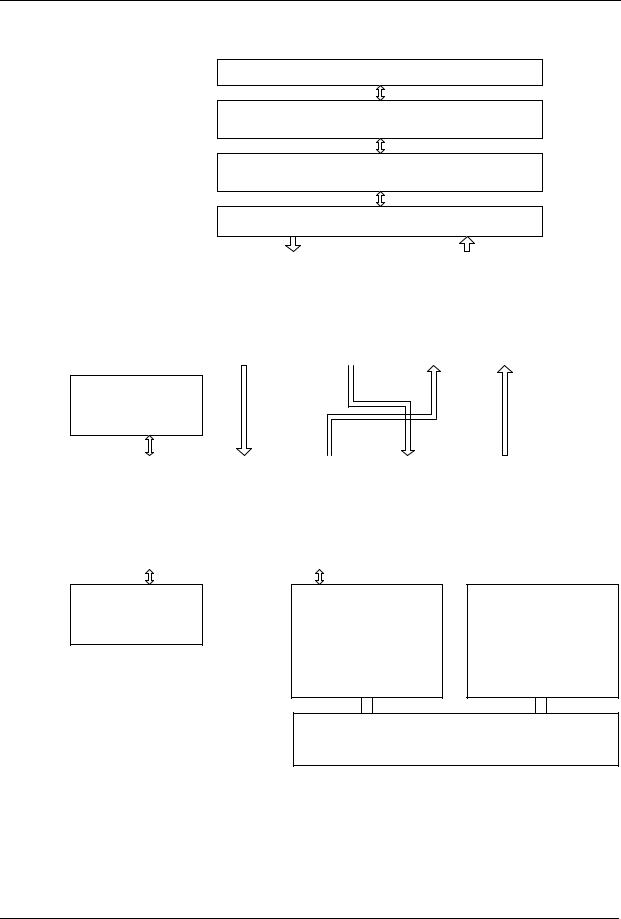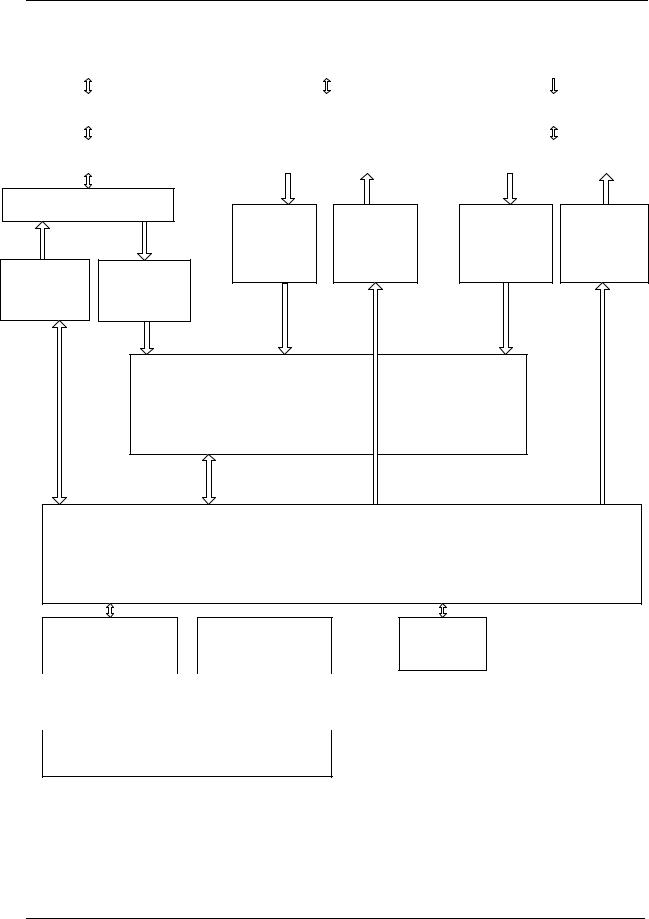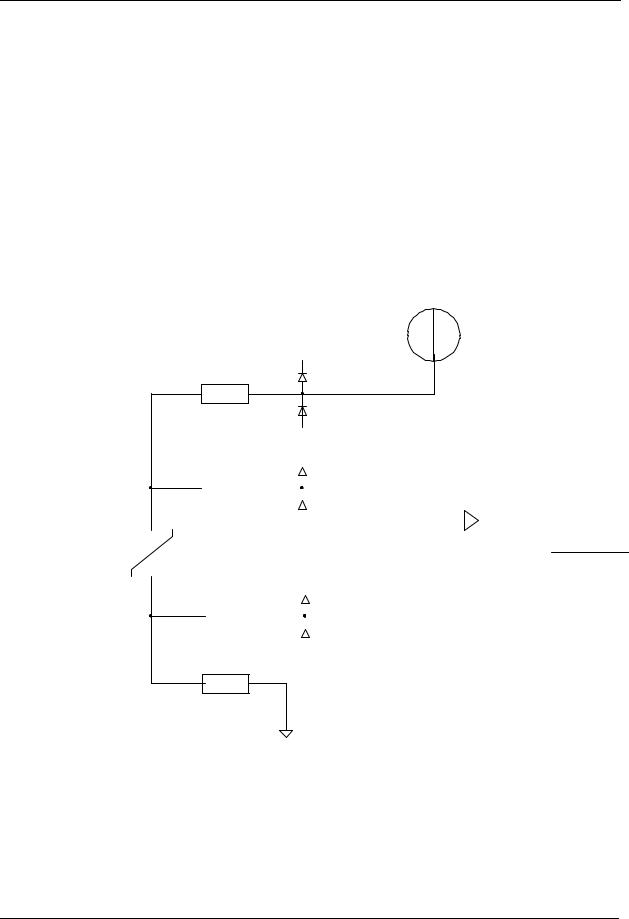Datex-Ohmeda S-5 Service Manual Datex S5

Datex-Ohmeda
Hemodynamic Modules
S/5TM PRESTN Module, M-PRESTN (Rev. 01)
S/5TM RESTN Module, M-RESTN (Rev. 01)
S/5TM PRETN Module, M-PRETN (Rev. 01)
Technical Reference Manual Slot
All specifications are subject to change without notice.
CAUTION: U.S. Federal law restricts this device to sale by or on the order of a licenced practitioner. Outside the USA, check local laws for any restriction that may apply.
|
Document No. 8005571-1 |
|
|
April 2004 |
|
Datex-Ohmeda, Inc. |
Datex-Ohmeda Division, Instrumentarium Corp. |
|
P.O. Box 7550, Madison |
P.O. Box 900, FIN-00031 |
|
DATEX-OHMEDA, FINLAND |
||
WI 53707-7550, USA |
||
Tel: +358 10 394 11 Fax: +358 9 146 3310 |
||
Tel: 1-608-221-1551 Fax: 1-608-222-9147 |
||
www.datex-ohmeda.com |
||
|
||
www.us.datex-ohmeda.com |
Instrumentarium Corp. All rights reserved. |
|
mailto:product.support.ussub@us.datex-ohmeda.com |
|

|
|
|
Table of contents |
|
|
||
TABLE OF CONTENTS |
|
||
S/5 Hemodynamic Modules |
|
||
TABLE OF CONTENTS |
i |
||
TABLE OF FIGURES |
iii |
||
Introduction |
|
1 |
|
1 |
Specifications |
3 |
|
1.1 |
General specifications .......................................................................................................................... |
3 |
|
1.2 |
Typical performance ............................................................................................................................. |
3 |
|
|
1.2.1 |
NIBP ........................................................................................................................................... |
3 |
|
1.2.2 |
ECG............................................................................................................................................. |
3 |
|
1.2.3 |
Pulse oximetry ............................................................................................................................. |
4 |
|
1.2.4 |
Temperature ................................................................................................................................ |
4 |
|
1.2.5 |
Invasive blood pressure................................................................................................................ |
5 |
|
1.2.6 |
Respiration.................................................................................................................................. |
5 |
1.3 |
Technical specifications........................................................................................................................ |
6 |
|
|
1.3.1 |
NIBP ........................................................................................................................................... |
6 |
|
1.3.2 |
ECG............................................................................................................................................. |
6 |
|
1.3.3 |
Pulse oximetry ............................................................................................................................. |
6 |
|
1.3.4 |
Temperature ................................................................................................................................ |
7 |
|
1.3.5 |
Invasive blood pressure................................................................................................................ |
7 |
|
1.3.6 |
Respiration.................................................................................................................................. |
7 |
2 |
Functional Description |
8 |
|
2.1 |
Measurement principle......................................................................................................................... |
8 |
|
|
2.1.1 |
NIBP ........................................................................................................................................... |
8 |
|
2.1.2 |
ECG............................................................................................................................................. |
8 |
|
2.1.3 |
Pulse oximetry ............................................................................................................................. |
8 |
|
2.1.4 |
Temperature .............................................................................................................................. |
10 |
|
2.1.5 |
Invasive blood pressure.............................................................................................................. |
10 |
|
2.1.6 |
Respiration................................................................................................................................ |
10 |
2.2 |
Main components .............................................................................................................................. |
11 |
|
|
2.2.1 |
M-PRESTN/-RESTN/-PRETN modules ......................................................................................... |
11 |
|
2.2.2 |
NIBP board................................................................................................................................ |
12 |
|
2.2.3 ECG board in 12-lead measurement ........................................................................................... |
15 |
|
|
2.2.4 |
ECG filtering............................................................................................................................... |
17 |
|
2.2.5 |
STP board.................................................................................................................................. |
18 |
2.3 |
Connectors and signals ...................................................................................................................... |
23 |
|
|
2.3.1 Module bus connector (on the NIBP board) ................................................................................. |
23 |
|
|
2.3.2 |
Front panel connectors............................................................................................................... |
25 |
|
2.3.3 Test points on boards ................................................................................................................. |
26 |
|
3 |
Service Procedures |
29 |
|
3.1 |
General service information ................................................................................................................ |
29 |
|
3.2 |
Service check..................................................................................................................................... |
29 |
|
|
3.2.1 |
Recommended tools.................................................................................................................. |
29 |
|
3.2.2 |
Recommended parts.................................................................................................................. |
29 |
3.3 |
Disassembly and reassembly.............................................................................................................. |
39 |
|
|
3.3.1 |
M-PRESTN/-RESTN/-PRETN modules ......................................................................................... |
39 |
3.4 |
Adjustments and calibrations ............................................................................................................. |
40 |
|
i
Document No. 8005571-1

Datex-Ohmeda S/5 monitors
|
3.4.1 |
NIBP calibrations....................................................................................................................... |
40 |
|
3.4.2 |
Temperature calibration ............................................................................................................. |
42 |
|
3.4.3 |
Invasive pressure calibration ...................................................................................................... |
42 |
4 |
Troubleshooting |
43 |
|
4.1 |
Troubleshooting charts ....................................................................................................................... |
43 |
|
|
4.1.1 |
NIBP ......................................................................................................................................... |
43 |
|
4.1.2 NIBP error code explanation ....................................................................................................... |
46 |
|
|
4.1.3 |
ECG .......................................................................................................................................... |
47 |
|
4.1.4 |
Pulse oximetry (SpO2) ................................................................................................................ |
47 |
|
4.1.5 |
Temperature.............................................................................................................................. |
48 |
|
4.1.6 |
Invasive blood pressure ............................................................................................................. |
49 |
|
4.1.7 |
Impedance respiration............................................................................................................... |
50 |
4.2 |
Troubleshooting flowcharts ................................................................................................................. |
51 |
|
|
4.2.1 M-PRESTN module troubleshooting for NIBP parameter............................................................... |
51 |
|
|
4.2.2 M-PRESTN module troubleshooting for parameters ESTPR ........................................................... |
52 |
|
5 |
Service Menu |
53 |
|
5.1 |
NIBP service menu ............................................................................................................................. |
54 |
|
|
5.1.2 |
NIBP demo menu....................................................................................................................... |
55 |
|
5.1.3 |
NIBP calibration menu ............................................................................................................... |
56 |
|
5.1.4 NIBP safety valve menu.............................................................................................................. |
57 |
|
|
5.1.5 NIBP pulse valve menu .............................................................................................................. |
58 |
|
|
5.1.6 |
NIBP buttons/leds menu............................................................................................................ |
59 |
|
5.1.7 |
NIBP pneumatics menu ............................................................................................................. |
60 |
|
5.1.8 |
NIBP watchdog menu................................................................................................................. |
61 |
|
5.1.9 |
ECG service menu...................................................................................................................... |
62 |
|
5.1.10 |
ECG setup menu.................................................................................................................... |
64 |
5.2 |
STP service menu............................................................................................................................... |
65 |
|
|
5.2.2 |
STP calibration menu ................................................................................................................. |
67 |
6 |
Spare Parts |
68 |
|
6.1 |
Spare parts list................................................................................................................................... |
68 |
|
|
6.1.1 M-PRESTN rev. 01, M-RESTN rev. 01, M-PRETN rev. 01 ............................................................... |
68 |
|
7 |
Earlier Revisions |
71 |
|
APPENDIX A |
|
73 |
|
Service Check Form |
1 |
||
ii
Document No. 8005571-1

|
|
Table of contents |
TABLE OF FIGURES |
|
|
Figure 1 S/5 PRESTN Module, M-PRESTN........................................................................................................... |
1 |
|
Figure 2 Absorption of infrared light in the finger probe parts layout and schematic diagram ................................. |
9 |
|
Figure 3 Front panel of M-PRESTN.................................................................................................................... |
11 |
|
Figure 4 NIBP board functional block diagram .................................................................................................. |
12 |
|
Figure 5 NIBP pneumatics diagram .................................................................................................................. |
14 |
|
Figure 6 12-lead ECG measurement block diagram .......................................................................................... |
15 |
|
Figure 7 STP board block diagram .................................................................................................................... |
18 |
|
Figure 8 Temperature measurement principle ................................................................................................... |
19 |
|
Figure 9 Pressure measurement principle ......................................................................................................... |
20 |
|
Figure 10 |
Pulse oximetry measurement block diagram.................................................................................... |
21 |
Figure 11 |
Serial communication of NIBP board............................................................................................... |
22 |
Figure 12 |
Serial Communication and Isolation of STP board............................................................................ |
22 |
Figure 13 |
Serial Communication and Isolation of ECG board ........................................................................... |
22 |
Figure 14 |
Module bus connector (X1) pin layout ............................................................................................. |
23 |
Figure 15 |
ECG board connectors and test points............................................................................................. |
26 |
Figure 16 |
NIBP board connectors and test points............................................................................................ |
27 |
Figure 17 |
STP board connectors and test points ............................................................................................. |
28 |
Figure 18 |
M-PRESTN module troubleshooting flowchart for NIBP Parameter..................................................... |
51 |
Figure 19 |
M-PRESTN Module Troubleshooting Flowchart for Parameters ESTPR................................................ |
52 |
Figure 20 |
Exploded view of M-PRESTN Module ............................................................................................... |
68 |
iii
Document No. 8005571-1

Datex-Ohmeda S/5 monitors
iv
Document No. 8005571-1

S/5 M-PRESTN Modules
INTRODUCTION
This Technical Reference Manual Slot provides information for the maintenance and service of the hemodynamic modules S/5 M-PRESTN/-RESTN/-PRETN. The modules are double width modules designed for use with S/5 monitors. Later in this manual modules may be referred to w/o the system name S/5 for simplicity.
Please also refer to Technical Reference Manual of the S/5 monitor for information regarding system specific information e.g. related documentation, conventions used, symbols on equipment, safety precautions, system description, system installation, interfacing, functional check and planned maintenance.
The M-PRESTN/-RESTN/-PRETN modules provide general hemodynamic parameters.
Auto |
Start |
Zero |
Zero |
On/Off |
Cancel |
P1 |
P2 |
NIBP |
|
SpO2 |
|
ECG |
|
|
|
|
T1 |
P1 |
|
|
T2 |
P2 |
|
NOTE: Do not use identical modules in the same monitor simultaneously.
The following modules are considered identical: M-ESTP/-EST/-ETP,
M-ESTPR/-ESTR/-ETPR, M-NESTPR/-NESTR/-NETPR, M-NE12STPR/-NE12STR/-NE12TPR M-PRESTN/M-RESTN/M-PRETN
Figure 1 |
S/5 PRESTN Module, M-PRESTN |
|
|
|
Table 1 |
Options of S/5 hemodynamic modules |
|
|
|
|
|
|
|
|
|
Parameter |
PRESTN |
RESTN |
PRETN |
|
|
|
|
|
P |
Two invasive blood pressures |
• |
|
• |
|
|
|
|
|
R |
Impedance respiration |
• |
• |
• |
|
|
|
|
|
E |
ECG |
• |
• |
• |
|
|
|
|
|
S |
Pulse oximetry |
• |
• |
|
|
|
|
|
|
T |
Two temperatures |
• |
• |
• |
|
|
|
|
|
N |
NIBP |
• |
• |
• |
|
|
|
|
|
NOTE: 12-lead ECG measurement requires Display Controller, B-DISP or B-DISPX. Intended purpose (Indications for use)
The Datex-Ohmeda PRESTN module (model family M-PRESTN) and accessories are indicated for monitoring of hemodynamic parameters of all hospital patients. The hemodynamic parameters of the module comprise ECG including ST-segment and arrhythmia, Impedance respiration, NIBP, Temperature,SpO2 (including monitoring during conditions of clinical patient motion),and invasive blood pressure.
1
Document No. 8005571-1

Datex-Ohmeda S/5 monitors
Impedance respiration measurement is indicated for patients aged 3 and up. The NIBP measurement is indicated for patients who weigh 5kg (11 lb.) and up. This device is indicated for use by qualified medical personnel only.
Monitor software compatibility
Datex-Ohmeda PRESTN rev. 01 module is designed for use with Datex-Ohmeda monitors using software as follows:
AM: L-ANE01(A) or later versions;
CCM: S-00C01 rev. 10.5, S-00C02 rev. 10.5 or newer versions;
CAM: S-00A05 rev. 10.9, S-00A06 rev. 10.9, L-00A07 rev. 10.9, L-00A08 rev. 10.9 or newer versions and
CCCM: S-00C03 rev. 10.9, S-00C04 rev. 10.9 or newer versions.
2
Document No. 8005571-1

S/5 M-PRESTN Modules
1 |
SPECIFICATIONS |
|
1.1 |
General specifications |
|
|
Module size |
75 ×180 ×112 mm |
|
W ×D ×H |
3.0 ×7.1 ×4.4 in |
|
Module weight |
0.7 kg / 1.5 lbs |
|
Power consumption |
about 6 W |
|
Operation temperature |
10 to 40 °C / 50 to 104 °F |
1.2 |
Typical performance |
|
1.2.1 NIBP
NOTE: Non-invasive blood pressure measurement is intended for patients weighing over 5 kg (11 lb.)
Oscillometric measurement principle.
Measurement range |
adult |
25 to 260 mmHg |
|
child |
25 to 195 mmHg |
|
infant |
15 to 145 mmHg |
Pulse rate range accepted |
30 to 250 bpm |
|
Measurement interval |
STAT (continuous 5 min), 1, 2.5, 3, 5, 10, 15, 30 and 60 min (1 h), |
|
|
2 and 4 h |
|
Typical measuring time |
adult |
23 s |
|
infant |
20 s |
Initial inflation pressure |
adult |
170 ±10 mmHg |
|
child |
150 ±10 mmHg |
|
infant |
120 ±10 mmHg |
Venous stasis |
adult |
40 ±5 mmHg / 2 min |
|
child |
40 ±5 mmHg / 2 min |
|
infant |
30 ±5 mmHg / 1 min |
Cuff widths |
please see User’s Guide |
|
1.2.2 ECG
Lead selection, 12-lead ECG Lead selection, other modules Sweep speeds
DISPLAY FILTER
Diagnostic, 12-lead ECG Diagnostic, other modules
Monitoring
I, II, III, aVR, aVL, aVF, V1, V2, V3, V4, V5, V6 I, II, III, aVR, aVL, aVF, V
12.5, 25, 50 mm/sec
0.05to 150 Hz
0.05to 100 Hz
0.5to 30 Hz (-3 dB, with 50 Hz reject filter)
0.5to 40 Hz (-3 dB, with 60 Hz reject filter)
3
Document No. 8005571-1

Datex-Ohmeda S/5 monitors
ST filter |
0.05 to 30 Hz (-3 dB, with 50 Hz reject filter) |
|
0.05 to 40 Hz (-3 dB, with 60 Hz reject filter) |
HEART RATE FROM ECG |
|
Range |
30 to 250 bpm |
Accuracy |
±5 bpm or ±5 %, whichever is greater |
Resolution |
1 bpm |
Update interval |
5 s |
Averaging time |
10 s |
ST LEVELS (in main software) |
|
ST level range |
-9 to +9 mm (-0.9 to +0.9 mV) |
Resolution |
0.1 mm (0.01 mV) |
Averaging |
calculated from 8 QRS |
SYNCHRONIZATION |
|
Direct ECG |
analog output of ECG, 1 V/1 mV |
Pacer |
5 V and 0.5 to 2.5 ms pulse, < 30 ms after pacer peak |
Defibrillator |
5 V and 10 ms pulse, < 35 ms after R-point synchronization |
1.2.3 Pulse oximetry
Measurement range |
0 to 100 % |
Calibration range |
70 to 100 % |
Accuracy1 |
100 to 70 %, ±2 digits |
|
±3 digits during clinical patient motion |
|
69 to 0 %, unspecified |
Display resolution |
1 digit = 1 % of SpO2 |
Display averaging time |
20, 10 sec, beat-to-beat |
Pulse beep pitch |
varies with SpO2 level |
The monitor is calibrated against functional oxygen saturation SpO2 func. |
|
PULSE RATE FROM PLETH |
|
Measurement range |
30 to 250 bpm |
Accuracy |
30 to 100, ±5 bpm, |
|
100 to 250, ±5 % |
Resolution |
1 bpm |
Display averaging |
10 s |
Adjustable pulse beep volume. |
|
PLETH WAVEFORM |
|
Scales |
2, 5, 10, 20, 50 mod%, Auto |
Start up scale is 20 mod% if AUTO is not selected to be the default setting. |
|
1.2.4 Temperature
Measurement range |
10 to 45 °C (50 to 113 °F) |
Measurement accuracy |
±0.1 °C (25 to 45.0 °C) |
1 Accuracy is based on deep hypoxia studies with volunteered subjects during motion and non-motion conditions over a wide range of arterial blood oxygen saturations as compared to arterial blood CO-Oximetry.
4
Document No. 8005571-1

S/5 M-PRESTN Modules
|
±0.2 °C (10 to 24.9 °C) |
Display resolution |
0.1 °C (0.1 °F) |
Temperature test |
automatic (every 10 min) |
Probe type |
compatible with YSI 400 series |
Single use sensors |
±0.2 °C (25 to 45.0 °C) |
|
±0.3 °C (10 to 24.9 °C) |
1.2.5 Invasive blood pressure
Measurement range |
-40 to 320 mmHg |
Measurement accuracy |
±2 mmHg or ±5 % |
Zero adjustment range |
±150 mmHg |
Calibration range |
±20 % |
Scales |
upper limit is adjustable between 10 and 300 mmHg in steps of |
|
10. Lower limit is 10 % of selected upper limit below zero. |
Sweep speed |
12.5, 25, 50 mm/s |
DIGITAL DISPLAY |
|
Range |
-40 to 320 mmHg |
Resolution |
±1 mmHg |
WAVEFORM DISPLAY |
|
Range |
-30 to 300 mmHg |
PULSE RATE FROM ARTERIAL PRESSURE |
|
Measurement range |
30 to 250 bpm |
Resolution |
1 bpm |
Accuracy |
±5 bpm or ±5 % whichever is greater |
1.2.6 Respiration
NOTE: The respiration measurement is intended for patients over three years old
Measurement range |
4 to 120 bpm |
Accuracy |
±5 bpm or ±5 % |
Resolution |
1 bpm |
Averaging time |
30 s |
Update interval |
10 s |
RESPIRATION WAVEFORM |
|
Sweep Speeds |
6.25 mm/s and 0.625 mm/s |
5
Document No. 8005571-1

Datex-Ohmeda S/5 monitors
1.3 Technical specifications
1.3.1 NIBP
Deflation rate, PR dep. |
3 to 8 mmHg/s |
|
|
Inflation time |
20 to 185 mmHg, 1 to 5 s |
||
Automatic software control, max. inflation pressure |
±10 mmHg |
||
|
adult |
280 |
|
|
child |
200 |
±10 mmHg |
|
infant |
145 |
±5 mmHg |
Over pressure limit, stops measurement after 2 seconds |
|||
|
adult |
320 mmHg |
|
|
child |
220 mmHg |
|
|
infant |
160 mmHg |
|
The safety circuit limits the maximum cuff pressure to 320 mmHg in adult/child mode or 160 mmHg in infant mode. Independent timing circuit limits pressurizing (>15 mmHg) time to 3 minutes maximum in adult/child mode, and 90 seconds at (>5mmHg ) in infant mode.
Zeroing to ambient pressure is done automatically.
Inflation pressure is adjusted according to the previous systolic pressure, typically 40 mmHg above. If the systolic pressure is not found, inflation pressure is increased typically 50 mmHg.
Max. measurement time |
adult |
120 s |
|
child |
120 s |
|
infant |
75 s |
Pressure transducer accuracy is better than ±3 mmHg or ±2 % whichever is greater. |
||
Max. error ±4 mmHg. |
|
|
Protection against electrical |
|
|
shock |
Type BF defibrillation proof |
|
1.3.2 ECG
Defibrillation protection |
5000 V, 360 J |
Recovery time |
5 s |
Input impedance |
>2.5 MΩ(10 Hz) |
CMRR |
≥95 dB (ST) |
System noise |
<30 µV (p-p, RTI) |
Allowable offset |
±800 mVDC |
Gain range |
0.2 to 5.0 cm/mV |
Pacemaker pulse detection |
2 to 700 mV, 0.5 to 2 ms pulses |
Protection against electrical |
|
shock |
Type CF defibrillator proof |
1.3.3 Pulse oximetry
Protection against electrical |
|
shock |
Type BF defibrillation proof |
6
Document No. 8005571-1

S/5 M-PRESTN Modules
1.3.4 Temperature
Measurement accuracy |
±0.1 °C (25.0 to 45.0 °C) |
|
±0.2 °C (10.0 to 24.9 °C) |
Protection against electrical |
|
shock |
Type CF defibrillation proof |
NOTE: The accuracy of the measurement may be different from the specified, depending on transducer/probe used. Please refer to the transducer/probe specification.
1.3.5 Invasive blood pressure
DIGITAL DISPLAY AVERAGING
Digital displays Art and P1 are averaged over 5 seconds and updated at 5 seconds intervals. All other pressures have respiration artifact rejection.
Accuracy ±5 % or ±2 mmHg, whichever is greater Transducer and input sensitivity
5 µV/V/mmHg, 5 VDC, 20 mA max current
0 to 4 - 22 Hz adjustable
±1 mmHg
±1 mmHg less than 15 s
Type CF defibrillation proof
NOTE: The accuracy of the measurement may be different from the specified, depending on transducer/probe used. Please refer to the transducer/probe specification.
1.3.6 Respiration
Excitation frequency, |
|
12-lead ECG |
31.25 kHz |
Breath detection |
automatic, range 0.3 to 6 Ωmanually adjustable minimum |
|
detection: 0.2, 0.4, 0.6, 0.8, 1.0 |
Input dynamic range |
0.2 to 32 Ω |
Input impedance range |
100 to 5000 Ω |
Respiration Rate |
min. 4 bpm |
|
max. 120 bpm |
Lead off detection |
>3 MΩ |
7
Document No. 8005571-1

Datex-Ohmeda S/5 monitors
2 FUNCTIONAL DESCRIPTION
2.1 Measurement principle
2.1.1 NIBP
NIBP (Non-Invasive Blood Pressure) is an indirect method for measuring blood pressure.
The NIBP measurement is performed according to the oscillometric measuring principle. The cuff is inflated with a pressure slightly higher than the presumed systolic pressure, and deflated at a speed based on the patient’s pulse, collecting data from the oscillations caused by the pulsating artery. Based on these oscillations, values for systolic, mean, and diastolic pressures are calculated.
The following parts are necessary for the NIBP measurement:
•M-PRESTN/-RESTN/-PRETN module
•twin hose (adult or infant model)
•blood pressure cuffs (various sizes)
2.1.2 ECG
Electrocardiography analyzes the electrical activity of the heart by measuring the electrical potential produced with electrodes placed on the surface of the body.
ECG reflects:
•electrical activity of the heart
•normal/abnormal function of the heart
•effects of anesthesia on heart function
•effects of surgery on heart function
See the User's Guide or the User’s Reference Manual for electrodes positions and other information.
2.1.3 Pulse oximetry
A pulse oximeter measures the light absorption of blood at two wavelengths, one in the near infrared (about 900 nm) and the other in the red region (about 660 nm) of the light spectrum. These wavelengths are emitted by LEDs in the SpO2 probe, the light is transmitted through peripheral tissue and is finally detected by a PIN-diode opposite the LEDs in the probe. The pulse oximeter derives the oxygen saturation (SpO2) using an empirically determined relationship between the relative absorption at the two wavelengths and the arterial oxygen saturation SaO2.
In order to measure the arterial saturation accurately, pulse oximeters use the component of light absorption giving variations synchronous with heart beat as primary information on the arterial saturation.
A general limitation of pulse oximetry is that due to the use of only two wavelengths only two hemoglobin species can be discriminated by the measurement.
The modern pulse oximeters are empirically calibrated either against fractional saturation SaO2frac;
8
Document No. 8005571-1

S/5 M-PRESTN Modules
SaO2frac = |
|
|
HbO2 |
Formula 1 |
||
|
|
|
|
|||
HbO2 +Hb +Dyshemoglobin |
||||||
|
|
|||||
or against functional saturation SaO2func; |
|
|||||
SaO2func = |
|
HbO2 |
|
Formula 2 |
||
|
HbO2 +Hb |
|||||
|
|
|
||||
Functional saturation is more insensitive to changes of carboxyhemoglobin and methemoglobin concentrations in blood.
The oxygen saturation percentage SpO2 measured by the Datex-Ohmeda module is calibrated against functional saturation SaO2func. The advantage of this method is that the accuracy of SpO2 measurement relative to SaO2func can be maintained even at rather high concentrations of carboxyhemoglobin in blood. Independent of the calibration method, pulse oximeters are not able to correctly measure oxygen content of the arterial blood at elevated carboxyhemoglobin or methemoglobin levels.
Plethysmographic pulse wave
The plethysmographic waveform is derived from the IR signal and reflects the blood pulsation at the measuring site. Thus the amplitude of the waveform represents the perfusion.
Pulse rate
The pulse rate calculation is done by peak detection of the plethysmographic pulse wave. The signals are filtered to reduce noise and checked to separate artifacts.
Probe
The standard probe is a finger clamp probe which contains the light source LEDs in one half and the photodiode detector in the other half. Different kinds of probes are available from Datex-Ohmeda.
SpO2 sensor connector
SpO2 sensor cable
|
6 |
GND |
|
|
Emitter |
IRED |
|
|
|
7 |
ILED |
of infrared.vsd |
||
|
||||
RED |
4 |
GND |
||
5 |
DEF_A |
|||
|
8 |
|
_ |
|
|
IS |
PRSTN absorption |
||
|
9 |
DET_C |
||
Detector |
|
|
||
|
|
|
Figure 2 |
Absorption of infrared light in the finger probe, parts layout and schematic |
|
diagram |
9
Document No. 8005571-1

Datex-Ohmeda S/5 monitors
2.1.4 Temperature
The temperature is measured by a probe whose resistance varies when the temperature changes, called NTC (Negative Temperature Coefficient) resistor.
The resistance can be measured by two complementary methods:
•Applying a constant voltage across the resistor and measuring the current that flows through it
•Applying a constant current through the resistor and measuring the voltage that is generated across it.
In Datex-Ohmeda modules the two methods are combined in the form of a voltage divider. The NTCresistor is connected in series with a normal resistor and a constant voltage is applied across them. The temperature dependent voltage can be detected at the junction of the resistors, thus producing the temperature signal from the patient. The signal is amplified by analog amplifiers and further processed by digital electronics.
2.1.5 Invasive blood pressure
To measure invasive blood pressure, a catheter is inserted into an artery or vein. The invasive pressure setup, consisting of connecting tubing, pressure transducer, an intravenous bag of normal saline all connected together by stopcocks, is attached to the catheter. The transducer is placed at the same level with the heart, and is electrically zeroed.
The transducer is a piezo-resistive device that converts the pressure signal to a voltage. The monitor interprets the voltage signal so that pressure data and pressure waveforms can be displayed.
2.1.6 Respiration
Impedance respiration is measured across the thorax between ECG electrodes. The respiration signal is made by supplying current between the electrodes and by measuring the differential current from the electrodes. The signal measured is the impedance change caused by breathing. From these impedance changes, respiration rate is calculated, and the respiration waveform is displayed on the screen.
10
Document No. 8005571-1

S/5 M-PRESTN Modules
2.2 Main components
2.2.1 M-PRESTN/-RESTN/-PRETN modules
Auto |
Start |
Zero |
Zero |
On/Off |
Cancel |
P1 |
P2 |
NIBP |
|
SpO2 |
|
ECG |
|
|
|
|
T1 |
P1 |
|
|
T2 |
P2 |
|
Figure 3 |
|
Front panel of M-PRESTN |
|
The M-PRESTN, M-RESTN, and M-PRETN modules contain three main PC boards, the STP board, the ECG board, and the NIBP board. They work independently. Each of these has their own processor and software in the processor flash memory.
There are two small boards, the SP input and the ECG input board attached to the front panel of the module. The front panel has seven connectors and four keys. The connectors are two for temperature measurement, two for invasive blood pressure measurement, one for ECG, one for NIBP, and one for SpO2 measurement. The keys are for NIBP Auto On/Off, NIBP Start/Cancel, P1 zero, and P2 zero.
11
Document No. 8005571-1

Datex-Ohmeda S/5 monitors
2.2.2 NIBP board
PATIENT AND NIBP CUFF
NIBP TUBING
NIBP CONNECTOR
NIBP PNEUMATICS
PRESSURE SENSORS |
|
DRIVERS FOR PUMP & |
|
VALVES |
|
|
|
|
|
|
|
NIBP CONTROL KEYS
MAIN CPU |
|
SAFETY CPU |
|
|
|
NV MEMORY
RS 485 COMMUNICATION |
POWER SUPPLY |
||||
|
|
|
|
|
|
|
|
|
|
|
|
NIBP BLOCK DIAGRAM
MODULE BUS CONNECTOR
Figure 4 |
NIBP board functional block diagram |
Signal processing
Two signals from the pressure transducers are amplified and sent to the A/D converter. After the converter, digitized signals are sent to the microprocessor for data processing.
The NIBP board is controlled with a H8/3052 microprocessor at 16 MHz oscillator frequency.
12
Document No. 8005571-1

S/5 M-PRESTN Modules
Memory
NIBP program memory (processor flash memory) size is 512k ×8. The processor has 4 kBytes RAM and there is also an external RAM memory the size of which is 128k x 8. Variable values of the NIBP measurement are stored into the external RAM. The EEPROM size is 512 x 8 and it is used to store the calibration values for the pressure transducers, the pulse valve constants gained during measurements, the PC board identification, and module serial number.
Software control
Software controls valves and pump. In addition to the individual on/off signals for each component there is a common power switch for the valves and the pump that can be used at pump/valve failures.
In addition to external RS485 reset line the microprocessor system is equipped with its own powerup reset. See the section in the ECG board’s description: “RS485 communication”
Safety circuit
The NIBP board is equipped with an independent safety circuit to disconnect supply voltages from the pump and the valves if the cuff has been pressurized longer than the preset maximum measurement time, or if the pressure of the cuff is inflated over the specified pressure limit. The maximum measurement time values and pressure limits for different measurement modes have been specified in the technical specification section of this manual.
Pneumatics
Pneumatics of PRESTN module has the following parts:
•Intake air filter; for preventing dust and other parts to enter the air pump and the valves.
•Air pump: for pumping the measuring pressure of the cuff.
•(Pulse) Valve; for producing a linear pressure fall (bleeding) in order to measure the blood pressure of the patient.
Note that there has been used also two other names Valve and Set valve to designate pulse valve in service menu.
•Safety valve; The safety valve has been intended to be used for deflating the cuff in single fault case, i.e. to prevent too long measurement time or too high inflation pressure of the cuff.
Note that there has been used also Exh2 valve to designate the Safety valve in service menu.
•Main pressure sensor; for measuring the pressure of the blood pressure cuff and the pressure fluctuations caused by arterial wall movement.
•Safety pressure sensor for detection of cuff hose type, cuff loose, cuff occlusion situations etc.and recognising the pressure sensor fault.
•Cuff connector; for connecting the cuff.
13
Document No. 8005571-1

Datex-Ohmeda S/5 monitors
Safety pressure sensor
Cuff connector
Proportional valve
Air pump
Dump valve
Main pressure sensor
Intake air filter
NIBP_pneum_diagr.vsd
Figure 5 |
NIBP pneumatics diagram |
Power supply section of the NIBP board
All connections are established via 25-pin connector (D-type, female). The module needs +15 V (dirty) power supply to operate. The supply voltage (+15V) is generated in the power supply section of the S/5 monitor. The other voltages needed for the operation of the NIBP measurement are made on the NIBP board.
14
Document No. 8005571-1

S/5 M-PRESTN Modules
2.2.3 ECG board in 12-lead measurement
The 12-lead ECG measurement consists of the elements shown in Figure 6. All functions are located in the ECG board except the ECG input unit .
PATIENT AND ECG ELECTRODES
ECG CABLE
-ECG LEAD SET
-ECG TRUNK CABLE
ECG INPUT UNIT
-ECG CONNECTOR
-INPUT PROTECTION RESISTORS
INPUT PROTECTION DIODES FOR ECG & RESPIRATION MEASUREMENT
INPUT FILTERING FOR ECG & RESPIRATION MEASUREMENTS
RESPIRATION |
|
RESPIRATION |
|
ECG PREAMPLIFIERS & |
|
LEADS OFF & PACER & |
MEASUREMENT |
|
MEASUREMENT CURRENT |
|
|
DEFIBRILLATION |
|
|
|
RLD CIRCUIT |
|
|||
AMPLIFIERS |
|
SUPPLY |
|
|
DETECTION |
|
|
|
|
|
|||
|
|
|
|
|
|
|
BASELINE
RESTORATION
ECG CPU
NV MEMORY
|
RS 485 COMMUNICATION |
|
POWER SUPPLY |
|
||||
|
ISOLATION |
|
ISOLATION |
|
||||
|
|
|
|
|
|
|
|
|
|
|
|
|
|
|
|
|
|
|
|
|
|
|
|
|
|
|
MODULE BUS CONNECTOR
ECG BLOCK DIAGRAM
Figure 6 |
12-lead ECG measurement block diagram |
15
Document No. 8005571-1

Datex-Ohmeda S/5 monitors
ECG input unit
The ECG input unit consists of the front panel connector and the ECG input connector board with the high voltage protection resistors. The connector for the 12-lead ECG cable is a green 11-pin rectangle shaped connector.
Input protection and filtering
The input protection is implemented with high voltage protection resistors in the ECG input unit and with protection diodes in the ECG board. The input filtering for ECG measurement is done with passive RC filtering.
ECG preamplifiers
The buffer amplifiers are used for each lead. The “Leads off” detection is implemented by measuring the output level of the input buffer amplifiers with A/D converter of CPU. The ECG signals are measured using differential amplifiers.
ECG amplifiers and baseline restoration
The function of the ECG amplifiers and baseline restoration is to amplify the signal and to restore the baseline of the signal in the middle of the display after the change of the signal level e.g. after the change of the DC offset voltage.
Pacer detection
Pacer detection has been made by using three slew rate detector circuits. The pacer detection amplifiers have been realized at the front of the slew rate detectors independently from the ECG measuring channels.
Respiration impedance supply
The 31.25 kHz sine wave generator is used as the respiration measurement signal supply. Analog switches are used for connecting the sine wave to the ECG leads to be measured.
Respiration impedance amplifiers
Buffer amplifiers are used in respiration measurement. Analog switches are used for selecting the measurement leads. There are also additional amplifiers for increasing the respiration signal gain. When ECG measurement is 5/12-lead, the respiration measurement is always done between R and F, independently on the ECG lead selection. When ECG measurement is 3-lead, then the respiration measurement is done at the same lead as the ECG measurement (I, II or III).
ECG CPU
The CPU is a 16 bit H8/3052 single-chip microcomputer. It contains 128 kbytes of flash memory and 4 kbytes of RAM. The clock frequency is 16 MHz.
16
Document No. 8005571-1

S/5 M-PRESTN Modules
RS485 communication
The communication to the CPU board of the monitor uses RS485 protocol. The RS485 driver circuits are optically isolated from the processor of the module. PWM signal is used for direct ECG signal. Direct ECG signal is available from the X2 connector of the UPI board or from the PT module.
Power supply
The ECG board has a driver controlled half bridge switching power supply with 5 kV isolation. The supply voltages have been regulated with linear regulators.
2.2.4 ECG filtering
The S/5 monitors have three ECG filtering modes:
MONITORING |
0.5 to 30 Hz (with 50 Hz reject filter) |
|
0.5 to 40 Hz (with 60 Hz reject filter) |
DIAGNOSTIC 12-lead ECG |
0.05 to 150 Hz |
ST FILTER |
0.05 to 30 Hz (with 50 Hz reject filter) |
|
0.05 to 40 Hz (with 60 Hz reject filter) |
The purpose of filtering is to reduce high frequency noise and low frequency (e.g. respiratory) movement artifacts.
Monitor filter is used in normal monitoring. Diagnostic filter is used if more accurate diagnostic information is needed. ST filter gives more accurate information of ST segment, but reduces high frequency noise.
The high-pass filters 0.5 Hz and 0.05 Hz are done with software. The monitor sends a command to the hemodynamic module determining which of the corner frequencies 0.5 Hz or 0.05 Hz is to be used.
The 50 Hz and 60 Hz reject filters are both low-pass filters with zero at 50 Hz or 60 Hz correspondingly. They are software based filters used for the mains supply filtering. With these filters the 3 dB value for low-pass filter is 30 Hz or 40 Hz.
In diagnostic mode the upper frequency is 150 Hz and it is limited by software.
17
Document No. 8005571-1

Datex-Ohmeda S/5 monitors
2.2.5 STP board
PATIENT AND SpO2 PROBE |
|
PATIENT AND TEMPERATURE |
|
PATIENT AND INVASIVE CANNULA |
|
SENSOR |
|
OR CATHETER |
|
|
|
|
||
|
|
|
|
|
SpO2 TRUNK CABLE |
|
TEMPERATURE CONNECTOR |
|
FLUSHING KIT & INVASIVE |
|
|
PRESSURE SENSOR WITH DOME |
||
|
|
|
|
|
|
|
|
|
|
|
|
|
|
|
SpO2 CONNECTOR |
|
INPUT PROTECTION CIRCUITRY |
|
INV.PRESSURE CONNECTOR |
|
|
|
|
|
SpO2 PROBE RECOGNITION & LED
DRIVE SELECTION MATRIX
TEMPERATURE |
SENSOR |
INV: PRESSURE |
SENSOR SIGNAL |
|
SIGNAL |
||||
MEASUREMENT |
MEASURE MENT |
VOLTAGE |
||
CURRENT |
||||
AMPLIFIER |
AMPLIFIER |
SOURCE |
||
SOURCE |
||||
|
|
|
SpO2 LED DRIVE |
SpO2 AMPLIFIER |
A/D CONVERSION
STP CPU
NV MEMORY
|
RS 485 COMMUNICATION |
|
POWER SUPPLY |
|
||||
|
ISOLATION |
|
ISOLATION |
|
||||
|
|
|
|
|
|
|
|
|
|
|
|
|
|
|
|
|
|
|
|
|
|
|
|
|
|
|
MODULE BUS CONNECTOR
STP BLOCK DIAGRAM
Figure 7 |
STP board block diagram |
18
Document No. 8005571-1

S/5 M-PRESTN Modules
Microprocessor unit
The CPU is a 16 bit H8/3052 single-chip microcomputer. It contains 128 kbytes of flash memory and 4 kbytes of RAM. The clock frequency is 16 MHz.
High speed I/O is used to obtain pulse control sequence necessary for pulse oximetry measurement. Timing for the clock is from the oscillator.
Temperature measurement unit
The NTC-resistor value in the probe depends on the patient’s temperature. It is measured with the following principle described below.
The constant current source is supplied about 7µA current through the temperature sensor (YSI 400-series NTC resistor). The constant current is caused a voltage over the temperature sensor (NTC resistor). The voltage over the temperature sensor is amplified in a differential amplifier stage. The amplified voltage is transferred to a controller of the STP board through an A/D converter.
Defibrillation/ESD protection |
constant |
current |
|
resistors and diodes |
source |
100k |
|
|
|
|
|
|
|
|
|
|
|
|
|
Differential |
|
|
|
|
|
|
|
|
|
|
|
|
|
|
|
|
|
||
|
|
|
|
10k |
|
|
|
|
|
|
|
amplifier |
|
|
|
|
|
|
|
|
|
|
|
|
|
|
|
|
|
||
|
|
|
|
|
|
|
|
||||||||
|
|
|
|
|
|
|
|
|
|
|
0 |
0 |
|
To A/D |
|
|
|
|
0C:7k36 |
|
|
|
|
|
|
|
|
||||
Temperature |
|
|
15C:3k54 |
|
|
|
|
|
|
|
d/dt |
converter |
|||
|
|
|
|
|
|
|
|
|
|
|
|||||
|
|
25C:2k53 |
|
|
|
|
|
|
|
|
0 |
||||
sensor |
|
|
|
|
|
|
|
|
|
|
|
|
|||
|
|
38C:1k30 |
|
|
|
|
|
|
|
|
|
|
|
||
|
|
|
45C: 984 |
|
|
|
|
|
|
|
0 |
|
|
|
|
|
|
|
|
|
|
|
|
|
|
|
|
||||
|
|
|
|
|
|
|
|
|
|
|
|
||||
|
|
|
|
|
|
|
|
|
|
|
|
|
|
|
|
|
|
|
|
|
|
|
|
|
|
|
|
|
|
|
|
|
|
|
|
|
|
|
|
|
|
|
|
|
|
|
|
|
|
|
|
|
|
|
|
|
|
|
|
|
|
|
|
|
|
|
|
10k |
|
|
|
|
|
|
|
|
|
|
|
|
|
|
|
|
|
|
|
|
|
|
|
|
|
|
|
|
|
|
|
|
|
|
|
|
|
|
|
|
|
|
|
|
|
|
|
|
|
|
|
|
|
|
|
|
|
|
|
100k
temp_meas_principle.vsd
Figure 8 |
Temperature measurement principle |
19
Document No. 8005571-1

Datex-Ohmeda S/5 monitors
Invasive blood pressure measurement unit
An isolated +5 V voltage is supplied to the pressure transducer. The differential voltage, which depends on the pressure and the supplied voltage, is calculated from the bridge connection (see the formula below).
Uout = Uin ×pressure ×5 V, where Uin is 5 VUout = 25 V ×pressure [mmHg]
Pressure amplification is realized in the instrumentation amplifier. The gain of the amplifier is set to keep the level of the signal transferred to A/D converter within the measurement range even when there are circumstantial offsets or offsets caused by the transducer. There is a filter before the amplifier to attenuate high frequency disturbances.
Vin |
Pressure |
|
transducer |
|
|
|
|
|
|
Vout |
Input |
|
|
Filter |
Instrumentation
amplifier
G
to AD converter principle.vsd _meas _pressure
Figure 9 |
Pressure measurement principle |
Pulse oximetry measurement section
LED control signals
The D/A converters of the microcontroller on STP board set the LED intensity adjustment values for the infraredand red LEDs of SpO2 probe. The microcontroller on the STP board switches ON ( to the adjusted intensity ) and OFF the SpO2 probe LEDs according to the predetermined sequence.
LED driving circuit
Differential amplifiers measure the LED currents (LED current indication) of SpO2 probe over the shunt resistors placed in the LED current paths. The LED driving voltages (LED voltage indication) are measured from the driver circuitry. The LED driving circuits also have MOSFET transistor matrix to enable the use of different probe configurations.
Measured signal preamplification
The preamplifier is bipolar/single-ended current-to-voltage converter with adjustable gain. A higher gain is used for measuring thin tissue. The preamplification stage has also ambient light reduction and second amplifier stage.
20
Document No. 8005571-1
